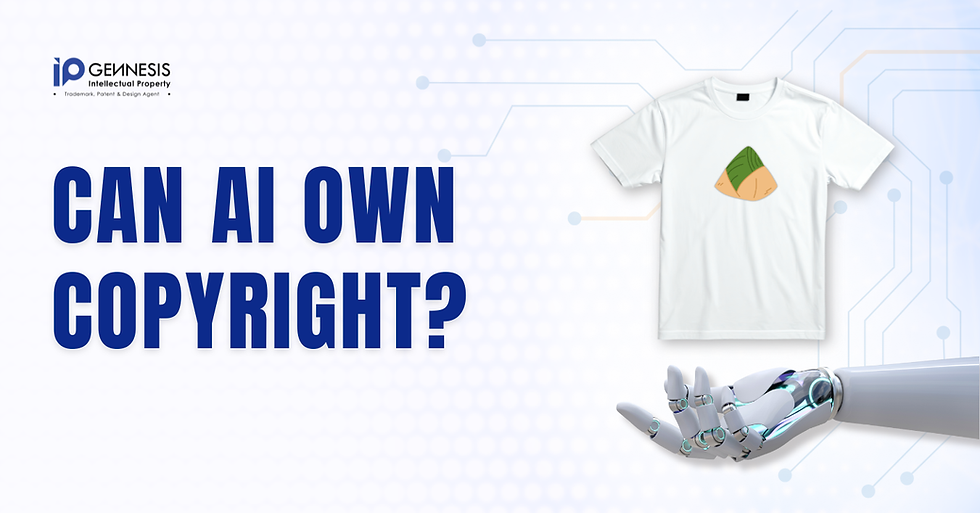Can AI Be an Inventor of a Patent?
- IP Gennesis

- May 3, 2024
- 4 min read
Imagine you created a super-smart AI that could come up with new inventions like gadgets or software all on its own. Now, imagine you wanted to claim those gadgets and software as your own inventions. That's the question at the heart of a recent UK Supreme Court case. The court had to decide if artificial intelligence, like a robot, could be listed as the inventor on a patent, which is a special right granted for a new invention.

The Heart of the Matter: Can AI Be an Inventor?
In the UK case, Thaler v Comptroller-General of Patents, Designs and Trade Marks [2023] UKSC 49, the court had to decide if artificial intelligence, like a robot, could be listed as the inventor on a patent, which is a special right granted for a new invention.
The Appellant of this case, Dr. Stephen Thaler created an AI system called DABUS, which he claimed had independently invented some new products. These included a new kind of food & beverages container, and a new type of light beacon and a new way of attracting attention in an emergency.
He wanted to get patents for these inventions just like any inventor would. But there was a big catch: the inventor wasn't a person. It was DABUS, the AI. In his patent applications for the inventions, he named the AI as the inventor and himself as the owner.
Therefore, the crux of the matter was whether an AI could quality as an inventor under the UK Patents Act 1977.
Before we go further with Dr. Thaler’s case, lets lay down the foundation a bit.
What’s the Difference Between Inventor and Owner?
In a patent application, usually, there are two names that need to be filled, ie the inventor and owner.
In simple terms, an inventor is the person who came up with the inventive idea behind the invention. This involves conceiving the idea and figuring out how to make it work in practice. An inventor must have contributed to the conception and materialisation of the invention as described in the patent application.
On the other hand, the owner of the patent, is the person or entity that hold the legal rights of the patent. This includes the rights to exploit the patent commercially, license it to others, and initiate legal action against infringers.
Can Inventor and Owner of a Patent be The Same Person?
Yes, inventor and owner can be the same person if the owner has contributed intellectually to the creation of invention. However, it is also quite common to see inventor and owner are different persons. The typical example would be when the patent owner is a company; whereas the inventor is an individual.
For example, if an inventor works for a company and creates the invention as part of their job, the company often owns the patent due to employment agreements or other arrangements that assign patent rights to the company.
Another example is, if a person commissioned an engineer to conceptualise, design and configure a new machine, the former will be the owner and the engineer will be named as the inventor in a patent application.
An Inventor of a Patent Must be Natural Person
Now, let’s get back to Dr. Thaler’s case. The UK Intellectual Property Office (UKIPO), High Court and Court of Appeal all held that under the UK Patents Act, an inventor must be a natural person. And, in this case, DABUS, the AI is a machine; it is not a person (whether natural or legal).
Eventually, the Court upheld the UKIPO’s decision in that Dr. Thaler’s patent application shall be taken to be withdrawn as he failed to make good the deficiency in the patent application, among other things, is to identify a person as the inventor of the invention within the prescribed period.
This case is not alone. Similar cases have popped up in other countries, and most have come to the same conclusion, reinforcing a global consensus on the human-centric nature of patent law.
What Does This Mean for Inventors and Tech Companies?
For people and companies using AI to help innovate, this means they need to think differently about how they handle patents. They need to make sure a human is involved in the creative process in a meaningful way.
Having said that, would the outcome of the case differ if Dr. Thaler had named himself as the inventor at the first place? Comment below to discuss!
Need help in filing a patent? Contact us! P/S: Judging from the above case, we would still suggest naming a natural person as the inventor of your patent (at least for the time being!)
**The full judgement of the case is available on UK Supreme Court website at this link
Written by,
Registered Trademark, Patent and Design Agent
LL.B (HONS), CLP
Advocate & Solicitor (Non-Practising)
Disclaimer: The above information is merely for general sharing and does not constitute any legal advice. Readers are advised to seek individual advice from professionals.
© 2024 by IP Gennesis Sdn Bhd.







Comments